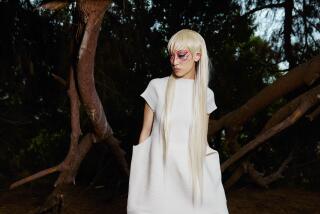Fashionable Tour of Pacific Rim Brings East to West
The yin and yang of it is that cranes and dragons have given way to bold graphics, richly embroidered silks to metallic fabrics.
The Medical, Dental and Legal Ladies Society, otherwise known as Medellas, met Saturday at the Anaheim Hilton and Towers for its annual luncheon and fashion show, which raised $12,000 for its scholarship program and the Historical and Cultural Foundation of Orange County.
More than 600 members of the group, all women of Asian heritage with professional degrees, looked on as Lois Rose Rose presented “Odyssey: A Fashion Quest.”
It was an odyssey around the East Asian countries and islands of the Pacific Rim, a quest across the centuries.
Rose paired costumes of Japan, China, Korea, Laos, Thailand, Malaysia, Hawaii, Vietnam and the Philippines with fashions by a dozen California-based designers of corresponding heritage.
Medellas members and their children modeled the traditional garments; professionals modeled their contemporary counterparts.
Rose, a Los Angeles-based fashion teacher, lecturer and businesswoman, began with authentic Japanese kimonos and ended with glittering evening wear by Philippine-born Ruben Panis.
Rose showed how antique kimono fabrics could be used for garments other than kimonos--pants, for example. She showed how a long, elaborately embroidered, hand-painted authentic kimono could be wrapped and tied at the hips and worn as a dress.
The contrasts were often startling.
From China, a dragon robe from the Ching Dynasty preceded Sue Wong’s dresses featuring optics and graphics. From Korea, subtlety and grace gave way to Olympics-inspired sportswear, including sequined sneakers.
From the Philippines came an antique, rather formal gown with high, stiff, butterfly shoulders. For the contemporary gowns that followed, Ruben Panis (a favorite designer of Los Angeles Mayor Tom Bradley’s wife, Ethel) used metallic fabrics to decidedly more flashy ends.
Panis was reached by phone Thursday at his shop in Los Angeles.
“Everybody tells me they see the Philippine influence in my clothes,” Panis said. “I don’t see it myself. If I make puff sleeves, people talk about the butterfly influence. Everything influences everything, but I must admit, the Oriental (effect) is not intentional.”
Many of the designers attended the show, among them Deanna Yorita and Judy Kamanishi of Ambiance et Cie in Tustin. Yorita also said she doesn’t consciously try to incorporate the Asian influence.
“Simplicity of line, versatility,” Yorita said, “these just come out. They’re part of our background.”
Linda Ito of San Jose-based Earthenware admits the influence of her Japanese roots is diminishing in her work.
“We’re becoming cross-cultural,” Ito said. “We’ve always used Japanese textiles. Now we’re using Guatemalan cottons and Chinese raw silks; my partner’s begun working with Peruvian designers. . . . The essence is still there. But it’s subtle. We don’t feel the need to be so blatant anymore.”
Diminishing or not, Rose--who herself was wearing a brightly colored 150-year-old Chinese collar over a ‘40s vintage American peplum top--feels those influences will never disappear entirely.
“Some of these designs are thousands of years old,” she pointed out after the show. “Whatever drapes easily, naturally, gracefully on the body--there will be variations, but the idea will keep turning up.
“The tradition of gorgeous handwork also continues. You can see that at needlework shows both in Asia and the United States. Appreciation of beautiful textiles, the interplay of yin and yang, balance and proportion, a sense of when it’s enough . . . these qualities will never be lost.”






